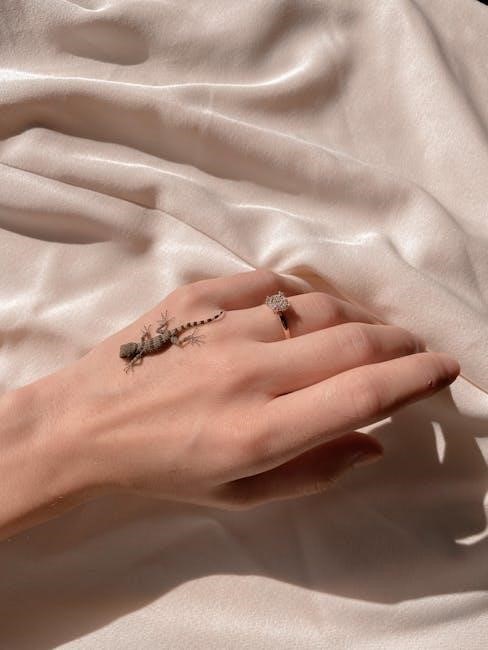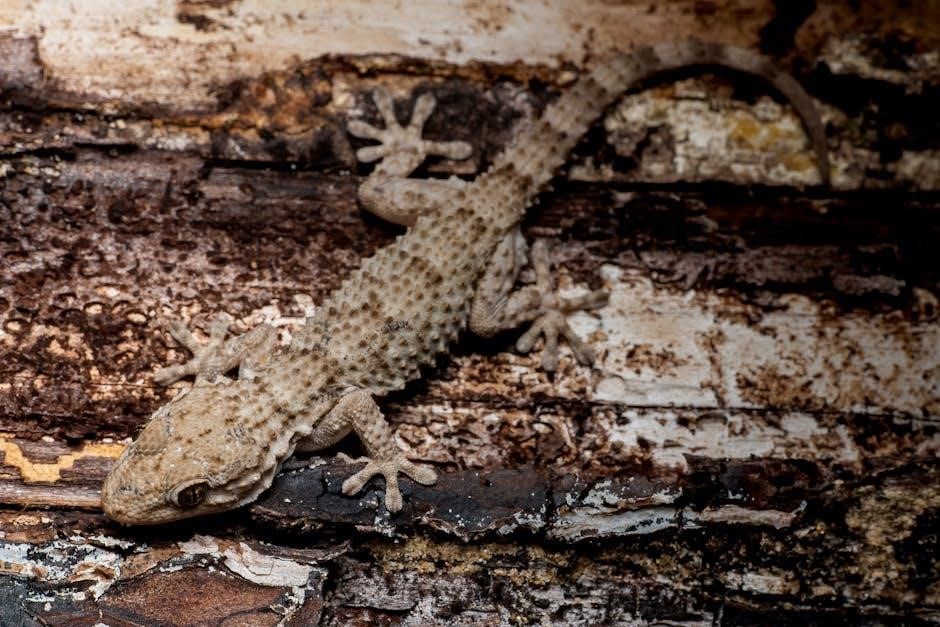Crested geckos, also known as Rhacodactylus ciliatus, are popular pets due to their stunning color, pattern, and scale variations, collectively referred to as morphs. These unique traits, influenced by genetics and environment, make each gecko distinct. Understanding morphs is essential for breeders and enthusiasts, as they determine the gecko’s appearance and value. This guide explores the diversity of crested gecko morphs, including color, pattern, scale, and eye variations, providing insights for selection and care. Whether you’re a seasoned breeder or a new enthusiast, this comprehensive overview will help you navigate the fascinating world of crested gecko morphs.
1.1 Overview of Crested Gecko Color and Pattern Variations
Crested geckos display a wide range of color and pattern variations, making them highly sought after. Common color morphs include Dalmatian, Leopard, and Flame, each with unique markings. Patterns vary from spots to stripes, with genetic traits influencing their expression. These variations result from selective breeding, emphasizing specific genetic traits. Understanding these color and pattern combinations is crucial for identifying and appreciating the diversity within crested gecko morphs, catering to both enthusiasts and breeders.
1.2 Importance of Understanding Morphs for Breeders and Enthusiasts
Understanding crested gecko morphs is vital for breeders and enthusiasts alike. Breeders rely on genetic knowledge to predict and reproduce desired traits, ensuring successful breeding programs. Enthusiasts benefit by appreciating the diversity and uniqueness of each morph, aiding in informed purchasing decisions. This knowledge enhances both breeding strategies and the overall enjoyment of these fascinating creatures, fostering a deeper connection with their genetic and aesthetic variations.

Types of Crested Gecko Morphs
Crested geckos exhibit diverse morphs, categorized into common, rare, and hybrid types, each showcasing unique color, pattern, and scale variations, reflecting their genetic diversity and appeal.
2.1 Common Crested Gecko Morphs: Dalmatian, Leopard, and Flame
The Dalmatian Crested Gecko features a white base with black spots, varying in pattern density. Leopard morphs display solid color with small, scattered spots, often in shades like yellow or brown. Flame morphs are recognized by their vibrant color intensity, particularly in reds and oranges. These common morphs are popular for their striking appearances and are often preferred by both newcomers and experienced enthusiasts for their visual appeal and manageable care.
2.2 Rare and Exotic Crested Gecko Morphs: Phantom, Axanthic, and Zero
Phantom Crested Geckos boast solid coloration without spots, creating a sleek appearance. Axanthic morphs lack yellow pigmentation, resulting in muted tones like gray or brown. Zero morphs exhibit minimal or no patterning, emphasizing their base color. These rare morphs are highly sought after by collectors for their unique beauty and limited availability, making them valuable additions to any collection.
2.3 Hybrid Morphs: Combining Different Traits for Unique Patterns
Hybrid Crested Gecko morphs blend traits from different morphs, creating unique patterns and colors. For example, crossing a Dalmatian with a Leopard can produce a “Super Leopard” with intensified spotting. Similarly, combining Flame with Dalmatian traits results in a “Fire Dalmatian” with vibrant, fiery markings. These hybrids allow breeders to experiment with genetics, resulting in one-of-a-kind geckos that showcase the diversity of Crested Gecko morphology, appealing to collectors and enthusiasts alike.

Crested Gecko Color Morphs
Crested Geckos display a wide range of color morphs, from common hues like cream and yellow to rare shades such as blue and purple, influenced by genetics.
3.1 Understanding the Genetics Behind Crested Gecko Colors
Crested Gecko color morphs are determined by genetic factors that control pigment production. Genes influence melanin and pterin levels, creating variations like yellow, red, and cream. Dominant and recessive traits, along with codominant expressions, produce unique hues. Epistatic interactions can mask or enhance colors. Environmental factors like temperature and diet may also impact color intensity, but genetics remain the primary driver of these vibrant morphs.
3.2 Popular Color Morphs: Cream, Yellow, and Red
Cream, Yellow, and Red are among the most sought-after Crested Gecko color morphs. Cream morphs display a light beige hue, while Yellow morphs range from soft butter to vibrant citrus tones. Red morphs showcase deep, rich colors, from orange-red to near-maroon. These morphs are prized for their striking appearances, and their popularity stems from genetic diversity and visual appeal. Proper care, including diet and lighting, enhances their color intensity and vibrancy.
3.3 Less Common Color Morphs: Blue, Green, and Purple
Blue, Green, and Purple Crested Gecko morphs are rare and highly unique, offering stunning visual appeal. These colors result from specific genetic combinations, with Blues ranging from pale sky to deep navy, Greens from mint to lime, and Purples from lavender to rich plum. Their rarity stems from complex genetic factors and breeding challenges. These morphs are highly sought after by enthusiasts for their striking beauty and unique charm, making them stand out in any collection.

Crested Gecko Pattern Morphs
Crested Gecko pattern morphs include spots, stripes, and unique designs like pinstripe or tiger patterns. These variations result from genetic combinations, creating visually striking appearances. Popular patterns like Super Dalmatian and Harlequin showcase diverse spot and stripe distributions, appealing to breeders and enthusiasts seeking distinct morphs.
4.1 Spot Patterns: Super Dalmatian and Dalmatian
Spot patterns are among the most popular Crested Gecko morphs, with Super Dalmatian and Dalmatian being standout examples. The Super Dalmatian features numerous small, evenly distributed spots, often expressing additional traits like flame or lemon. In contrast, the Dalmatian morph showcases larger, more contrasting spots with a cleaner base color. Both morphs are highly sought after for their striking visual appeal and genetic diversity, making them favorites among enthusiasts and breeders alike.
4.2 Stripe Patterns: Extreme Harlequin and Harlequin
Stripe patterns in Crested Geckos are characterized by bold, linear markings, with the Extreme Harlequin and Harlequin being prominent examples. The Extreme Harlequin boasts intense, contrasting stripes that often cover most of the body, creating a striking contrast. The standard Harlequin features broader, less intense stripes with a cleaner base color. Both morphs are highly sought after for their aesthetic appeal and genetic uniqueness, making them a favorite among collectors and breeders who appreciate distinctive patterns.
4.3 Other Unique Patterns: Pinstripe, Mocha, and Tiger
The Pinstripe pattern features thin, delicate stripes running along the gecko’s back, adding a refined look. The Mocha morph displays warm, earthy tones with subtle, swirling patterns, creating a natural aesthetic. The Tiger pattern showcases bold, stripe-like markings reminiscent of a tiger, often with vibrant colors. These unique patterns add diversity to Crested Gecko morphs, appealing to enthusiasts who appreciate distinct and eye-catching visual traits in their pets.

Crested Gecko Scale Morphs
Crested Gecko scale morphs vary in texture and structure, influenced by genetics. They exhibit unique traits like crested scales or de-crested forms, adding diversity and interest for enthusiasts and breeders.
5.1 Crested vs. De-Crested Geckos: Understanding Scale Differences
Crested geckos are known for their fleshy, hair-like scales forming a “crest” along their eyes and tail. De-crested geckos lack these structures due to genetic variations. Crested scales are soft and fringed, while de-crested geckos have smoother, more traditional scales. This difference impacts their appearance but not their overall health or behavior. Breeders and enthusiasts often appreciate both types for their unique traits and genetic diversity.
5.2 Scale Texture Variations: Smooth, Velcro, and Fuzzy
Crested geckos exhibit three primary scale textures: Smooth, Velcro, and Fuzzy. Smooth scales are flat and sleek, offering a minimalist appearance. Velcro scales have a slightly textured, rougher feel, resembling the hook side of Velcro. Fuzzy scales are soft and downy, creating a fluffy texture. These variations enhance the geckos’ visual appeal and provide functional benefits, such as improved grip or insulation, making each texture unique and desirable among enthusiasts and breeders.
Crested Gecko Eye Morphs
Crested geckos display a variety of eye morphs, including color variations like Albino and Ruby, and unique patterns such as Solid, Marbled, and Eclipse. These traits enhance their visual appeal and genetic diversity.
6.1 Eye Color Variations: Albino, Ruby, and Anery
Crested geckos exhibit stunning eye color variations, including Albino, Ruby, and Anery. Albino geckos lack pigmentation, resulting in pink eyes, while Ruby eyes display an intense red hue due to heightened pigmentation. Anery geckos, lacking red and yellow pigments, often appear washed out with grey or pale eyes; These variations are genetically determined and highly sought after for their unique visual appeal. They add diversity to the species and are key factors in breeding programs focused on rare traits.
6.2 Eye Pattern Variations: Solid, Marbled, and Eclipse
Crested geckos display eye pattern variations such as Solid, Marbled, and Eclipse. Solid eyes feature a single, uniform color, while Marbled eyes exhibit a mix of colors, creating a unique marbled effect. Eclipse eyes have a distinct ring around the pupil, contrasting with the central color. These patterns enhance the gecko’s visual appeal and are highly valued by enthusiasts and breeders for their aesthetic diversity and genetic uniqueness.

Factors Influencing Crested Gecko Morphs
Genetics, environment, and age significantly influence crested gecko morphs. Genetic traits determine base colors and patterns, while environmental factors like temperature and diet can affect expression. Age also plays a role, as morphs often develop and change as geckos mature.
7.1 Genetic Influence on Crested Gecko Morph Development
Genetics play a crucial role in determining crested gecko morphs. Specific genes control color, pattern, and scale traits, with dominant, recessive, and codominant expressions shaping their appearance. For instance, certain genes dictate the presence of spots or stripes, while others influence color intensity. Understanding these genetic principles helps breeders predict and achieve desired morph traits. Genetic diversity ensures a wide variety of unique and fascinating crested gecko morphs, making each individual distinctive.
7.2 Environmental Factors: Temperature, Humidity, and Diet
Environmental factors significantly impact crested gecko morph development. Temperature influences metabolism and color intensity, with optimal ranges between 75-85°F. Humidity levels, ideally 50-70%, affect skin health and pattern clarity. Diet plays a role in overall health, with nutrient-rich foods enhancing color vibrancy and pattern expression. While genetics determine base traits, environment fine-tunes their expression, ensuring geckos thrive and display their morph characteristics effectively.
7.3 Age and Morph Expression: How Morphs Change with Time
Crested geckos’ morphs evolve with age, as juveniles often display different traits than adults. Hatchlings may lack distinct patterns, which emerge and intensify as they mature. Color vibrancy and pattern complexity typically peak in adulthood. Environmental and genetic factors influence this transformation, while some morphs, like eye color, stabilize early. Understanding age-related changes helps enthusiasts and breeders predict and appreciate their geckos’ full potential over time, enhancing their unique appeal.
How to Identify Crested Gecko Morphs
Identifying crested gecko morphs involves analyzing color, pattern, and scale traits. Visual inspection and genetic testing are key tools for accurate identification and verification of morph characteristics.
8.1 Visual Identification: Color, Pattern, and Scale Type
Visual identification of crested gecko morphs involves examining their color, pattern, and scale type. Colors range from vibrant hues like red and yellow to rare shades like blue and purple. Patterns include spots, stripes, and unique designs such as pinstripe or tiger. Scale types vary between smooth, velcro, or fuzzy textures. Detailed observation of these traits helps enthusiasts and breeders accurately identify and classify morphs, ensuring proper identification and documentation of their unique characteristics.
8.2 Genetic Testing for Accurate Morph Identification
Genetic testing is a reliable method for accurately identifying crested gecko morphs. By analyzing DNA, breeders can determine specific traits and morph variations. This process helps confirm morph characteristics, especially for ambiguous or hard-to-identify geckos. Genetic testing is more precise than visual inspection alone, ensuring accurate identification and aiding breeders in predicting offspring traits. It is a valuable tool for enthusiasts seeking to understand their geckos’ genetic makeup fully.

Choosing the Right Crested Gecko Morph
When selecting a crested gecko morph, consider personal preference, experience level, and budget. Research traits and care needs to ensure compatibility and satisfaction.
9.1 Tips for Beginners: Selecting a Morph That Suits Your Preferences
For new hobbyists, start with common morphs like Dalmatian or Leopard, as they are hardy and easier to care for. Consider color and pattern preferences to ensure satisfaction. Research temperament and care needs, even if briefly, to make an informed choice. Set a budget, as rare morphs can be costly. Check availability and reach out to breeders or pet stores for recommendations to find the perfect match for your lifestyle and interests.
9.2 Considerations for Breeders: Selecting Morphs for Breeding Purposes
For breeders, prioritizing genetic diversity is key to producing unique and desirable traits. Focus on morphs with recessive or dominant genes to enhance offspring variety. Research market demand to align breeding goals with buyer preferences. Ensure proper documentation of lineage and traits to maintain transparency. Consider the potential for creating rare or hybrid morphs to stand out in the market. Always aim for healthy, high-quality specimens to ensure successful breeding outcomes.
9.3 Budget and Availability: Rare vs. Common Morphs
Budget plays a significant role in selecting crested gecko morphs. Rare morphs, like Phantoms or Axanthics, are often more expensive due to their unique traits. Common morphs, such as Dalmatians, are more affordable and widely available. Availability varies by region and breeder, with rare morphs being harder to find. Consider your budget and whether you prioritize owning a rare or common morph. Research reputable breeders to find morphs within your price range.

Caring for Crested Gecko Morphs
Proper care involves a well-ventilated habitat, balanced diet, and appropriate temperature/humidity levels. Regular monitoring ensures health, while morph-specific needs may require tailored attention.
10.1 General Care Tips for Crested Geckos
Provide a well-ventilated, spacious enclosure with appropriate substrate and décor. Maintain a temperature range of 75-85°F with a slight drop at night. Use low-wattage lighting to avoid overheating. Ensure humidity levels between 50-60% by misting daily. Offer a balanced diet of commercial crested gecko food and occasional live insects. Provide fresh water in a shallow dish. Clean the habitat regularly to prevent bacterial growth. Monitor health and behavior to ensure optimal well-being;
10.2 Specialized Care for Specific Morphs
Certain morphs may require tailored care. For example, crested geckos with intense coloration or unique patterns might need adjusted lighting to avoid stress. Velcro morphs benefit from higher humidity to maintain skin health. Light-sensitive morphs, like Phantoms, may require dimmer lighting. Scale texture variations, such as Fuzzy geckos, need gentle handling to protect their sensitive skin. Research specific morph needs to ensure optimal care and prevent health issues.

Crested Gecko Morph Terminology
Understanding terms like dominant, recessive, codominant, and sex-linked helps in identifying morphs. These genetic terms explain how traits are inherited, guiding breeders and enthusiasts effectively.
11.1 Glossary of Common Terms Used in Crested Gecko Morphs
A morph refers to a gecko’s physical appearance, including color and pattern. Phenotype describes the visible traits, while genotype refers to the genetic makeup. Dominant traits always show, recessive require two copies, and codominant traits blend. Sex-linked traits are tied to sex chromosomes. These terms help breeders and enthusiasts understand and classify Crested Gecko variations effectively.
11.2 Understanding Genetic Terms: Dominant, Recessive, and Codominant
In genetics, dominant traits are expressed when an allele is present, overriding recessive traits, which only appear without the dominant allele; Codominant traits blend, showing both alleles’ effects. For example, in Crested Geckos, dominant genes like Dalmatian spots mask other patterns, while recessive traits require specific breeding. These genetic interactions help predict morph outcomes, aiding breeders and enthusiasts in creating unique Crested Gecko variations through selective breeding practices and genetic understanding.

Crested Gecko Morph Market Trends
The market for Crested Gecko morphs is driven by demand for rare and unique variations. Prices fluctuate based on morph rarity, with high-demand morphs often commanding premium prices.
12.1 Current Popular Morphs in the Market
Currently, Dalmatian, Leopard, and Flame morphs are highly sought after for their striking patterns and vibrant colors. These morphs are popular among hobbyists and breeders due to their unique visual appeal. Additionally, rare morphs like Phantom and Axanthic are gaining traction, offering a modern aesthetic. The demand for these morphs often drives their popularity, making them a focal point in the Crested Gecko market.
12.2 Emerging Trends in Crested Gecko Morphs
Emerging trends in Crested Gecko morphs include the rise of hybrid morphs combining rare traits; Breeders are focusing on enhancing color intensity and pattern complexity. Zero and Phantom morphs are gaining popularity for their unique aesthetics. Additionally, there is growing interest in morphs with extreme scale texture variations. These trends reflect a shift toward more exotic and visually striking geckos, driven by advancements in breeding techniques and genetic understanding.
12.3 Pricing Trends: How Morph Rarity Affects Value
The value of Crested Gecko morphs is heavily influenced by their rarity. Rare morphs, such as Zero and Phantom, often command higher prices due to their unique genetic traits and limited availability. As demand increases, so does the price, especially for morphs with striking color or pattern combinations. Common morphs remain more affordable, while exotic ones can fetch premium prices, reflecting their exclusivity and the skill required to breed them.
Crested Gecko morphs offer incredible diversity, with unique color, pattern, and scale variations, making them a fascinating choice for both novice and experienced enthusiasts alike.
13.1 Summary of Crested Gecko Morphs and Their Significance
Crested Gecko morphs showcase stunning diversity in color, pattern, and scale variations, influenced by genetics. These unique traits enhance their appeal, making them popular among hobbyists and breeders. Understanding morphs aids in appreciation, breeding, and conservation efforts. Their variety highlights the species’ genetic complexity and adaptability, offering endless opportunities for enthusiasts to explore and connect with these captivating creatures.
13.2 Final Thoughts on Choosing and Caring for Crested Gecko Morphs
When selecting a Crested Gecko morph, prioritize your preferences, budget, and the gecko’s specific needs. Proper care, including a suitable habitat and balanced diet, ensures their well-being. Research and understanding morph traits will enhance your experience. Whether for companionship or breeding, Crested Geckos offer a rewarding journey. Enjoy the unique bond and beauty these fascinating creatures bring to your life.

0 Comments